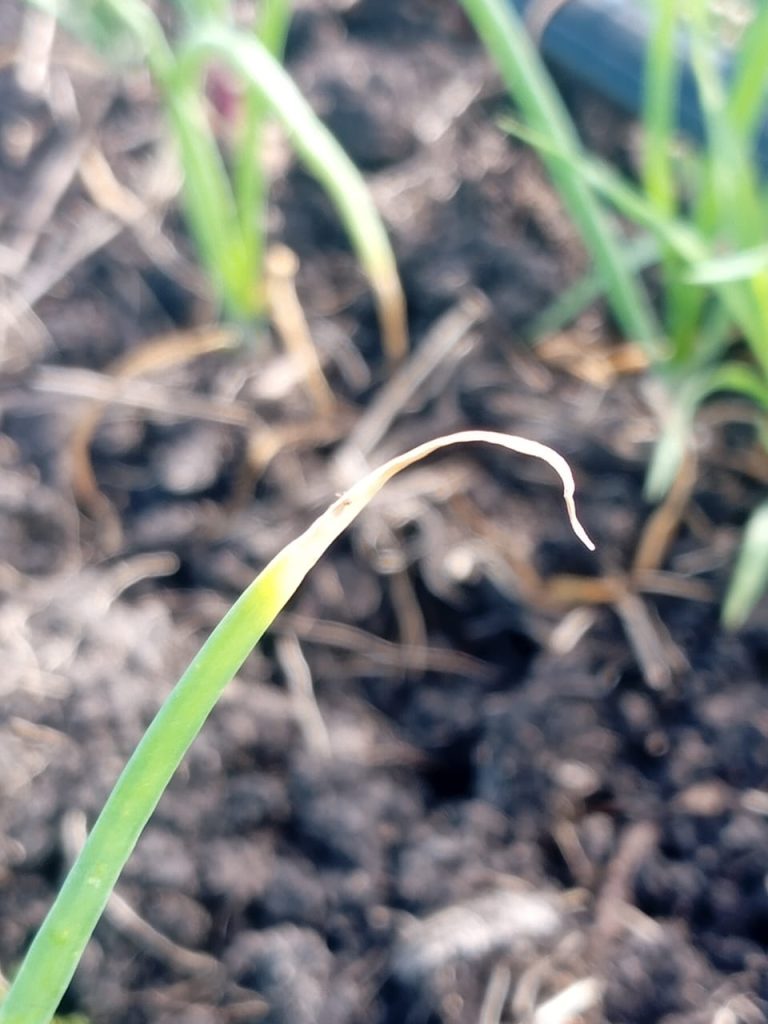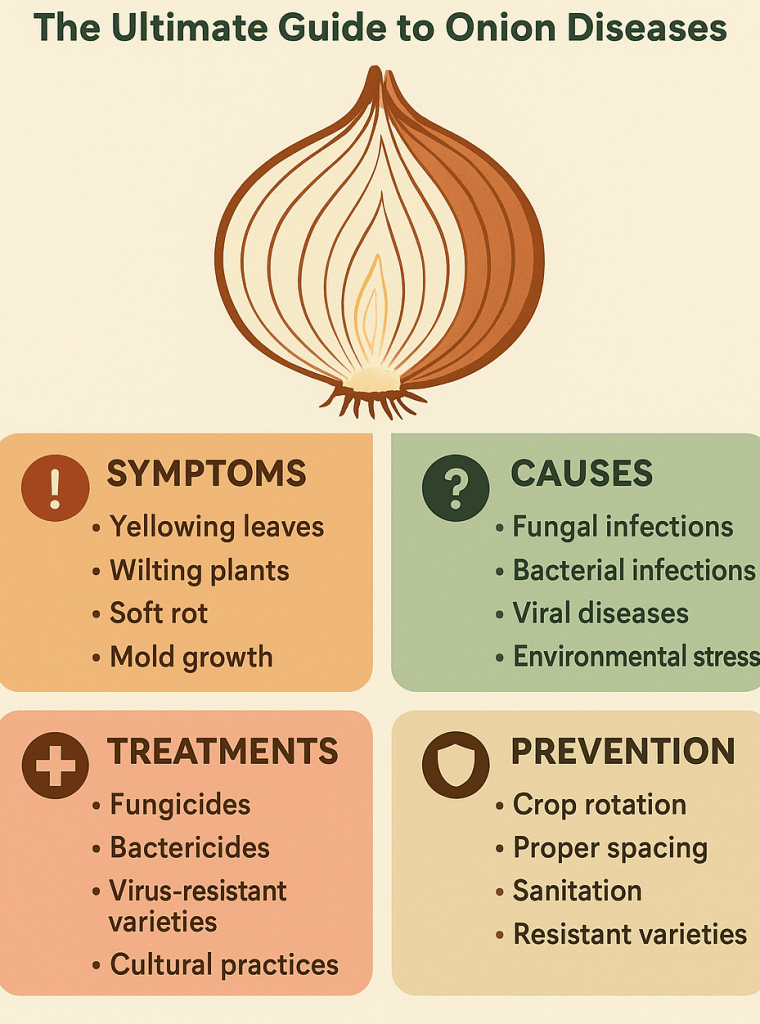Welcome to the Onion Doctor blog, where we dive deep into the world of onions If you’re an onion farmer, gardener, or just someone who loves these pungent powerhouses, you’ve come to the right place. Onions are like the superheroes of the kitchen – versatile, flavorful, and full of health benefits. But even superheroes have their kryptonite: diseases that can turn your thriving crop into a weepy mess. In this ultimate guide we’re aiming for onion diseases we’ll explore the most common onion diseases, their sneaky symptoms, root causes, effective treatments, and foolproof prevention tips. Whether you’re dealing with fungal foes, bacterial bullies, or viral villains, we’ve got you covered. Why focus on onion diseases? Because early detection can save your harvest, boost yields, and keep your onions healthy and happy. Ready to peel back the layers? Let’s dig in!

COMMON ONION DISEASE: SYMPTOMS,CAUSES,TREATMENT AND PREVENTION:
1.DOWNEY MILDEW:
- Cause: A fungal like oomycete that thrives in Kenya`s cool wet seasons
- Symptoms: Pale green to Yellow spots: Small, pale green or yellowish patches appear on the upper surface of the leaves and stalks.
- Treatments: Once it hits, remove infected plants immediately to stop the spread. Apply fungicides like mancozeb or copper-based sprays every 7-10 days during wet spells.
- Prevention: Plant in well-drained soil with good air circulation – think single rows spaced 12-18 inches apart. Rotate crops every 3-4 years (no alliums like garlic in between). Use disease-free seeds and avoid overhead watering to keep leaves dry.

2.WHITE ROT:
- Symptoms: Yellowing and wilting leaves starting from the older ones. Bulbs soften, develop white fluffy growth at the base, and may have tiny black sclerotia (like peppercorns). Plants stunt and die, leaving a mushy mess.
- Causes: Fungus Sclerotium cepivorum lurks in soil for up to 20 years! It attacks roots in cool, moist soil (below 68°F) and spreads via contaminated tools or water.
- Treatments: Fungicides like tebuconazole can help if applied early as a soil drench. But often, it’s too late – remove and destroy infected plants (don’t compost them!).
- Prevention: Long crop rotation (4-8 years with non-host plants like cereals). Use hot water-treated seeds. Improve soil drainage and avoid planting in infected areas. Soil solarization (covering with plastic for 4-6 weeks in summer) can kill the fungus

3.PINK ROT:
- Symptoms: Roots turn light pink, then darken to red-purple, shrivel, and become transparent. Leaves yellow, plants wilt and stunt, bulbs are small and shriveled. Seedlings may die young.
- Causes: Soil-borne fungus Phoma terrestris (or Pyrenochaeta terrestris). It thrives in warm soils (above 75°F) and builds up with repeated onion planting.
- Treatments: No cure once infected, but fungicides like thiophanate-methyl can protect new plants. Pull and discard affected ones.
- Prevention: Rotate crops for 3-6 years. Plant resistant varieties (check labels for pink root resistance). Soil fumigation or solarization helps reduce pathogen levels

4.FUSARIUM BASAL ROT:
- Symptoms: Yellowing and wilting leaves from the tips down. Basal plate rots, turning brown and watery. Bulbs soften with white or pinkish mold.
- Causes: Fungus Fusarium oxysporum f. sp. cepae, surviving in soil debris. Favored by warm, wet conditions and stressed plants (e.g., from over-fertilizing).
- Treatments: Remove infected plants. Soil drenches with fungicides like propiconazole may slow it.
- Prevention: Use certified disease-free seeds or sets. Rotate every 4 years. Avoid excess nitrogen and ensure good drainage. Hot water seed treatment (122°F for 20 minutes) kills spores.

5.PURPLE BLOTCH:
- Symptoms: Small tan spots that enlarge to purple-zoned lesions with yellow halos. Leaves die back, bulbs may rot if severe.
- Causes: Fungus Alternaria porri, spreading in warm, wet weather via wind and rain.
- Treatments: Fungicide sprays like Mancozeb every 7-10 days during humid periods.
- Prevention: Crop rotation, good spacing for air flow, debris removal. Time irrigation for daytime drying.

GENERAL PREVENTION TIPS :
- Crop Rotation: 3-4 years minimum, avoiding alliums.
- Soil Health: Well-drained, pH 6-7, test for nutrients.
- Planting Practices: Use certified seeds/sets, space for air flow.
- Water Wisely: Drip irrigation, morning watering to dry leaves.
- Sanitation: Remove debris, disinfect tools.
- Monitoring: Scout weekly for early symptoms.
- Resistant Varieties: Choose hybrids like Neptune for broad resistance.
- Organic Options: Neem oil, compost teas for mild cases.

Contact us for: Onion seedlings, Garlic seedlings, Germinated garlic cloves, Farm planning services, Soil testing, training on onion and garlic growing, Drip irrigation installation and maintenance, Agronomic support, Onion and Garlic value pack and Farm management. For free consultation, placing orders or booking a visit with an agronomist, please contact us via Call or what’s app +254703982228, Email: Info@oniondoctor.co.ke. You can also check out our social media handles for daily updates on TikTok: https://www.tiktok.com/@oniondoctorke?_t=ZM-8wmsTu0qumO&_r=1 Instagram: https://www.instagram.com/oniondoctorke?igsh=MTVoaHF3aWUydTJzaQ==Facebook:https://www.facebook.com/share/16SwgYn2dG/ Youtube:https://youtube.com/@oniondoctorke?si=u5Jnd-r0qU9UDYqL and Twitter: https://x.com/OnionDoctorKe?t=FR3JXlS_oN1vjjUgAtfyzg&s=09.